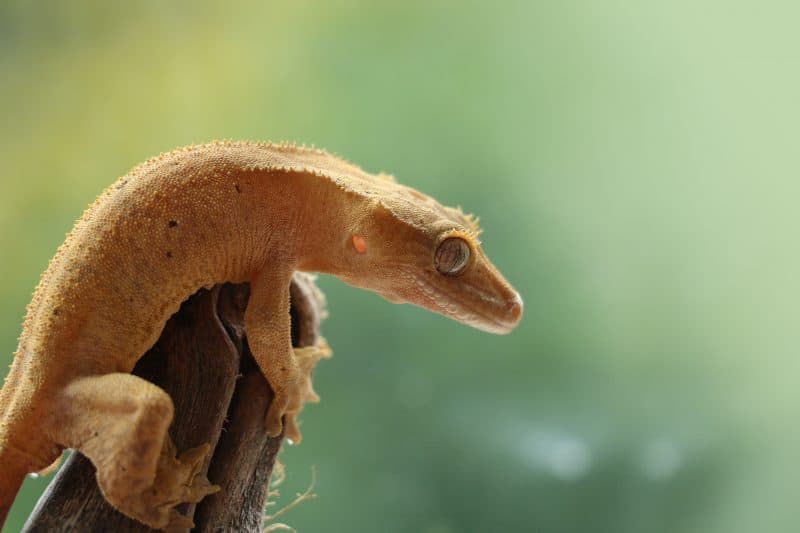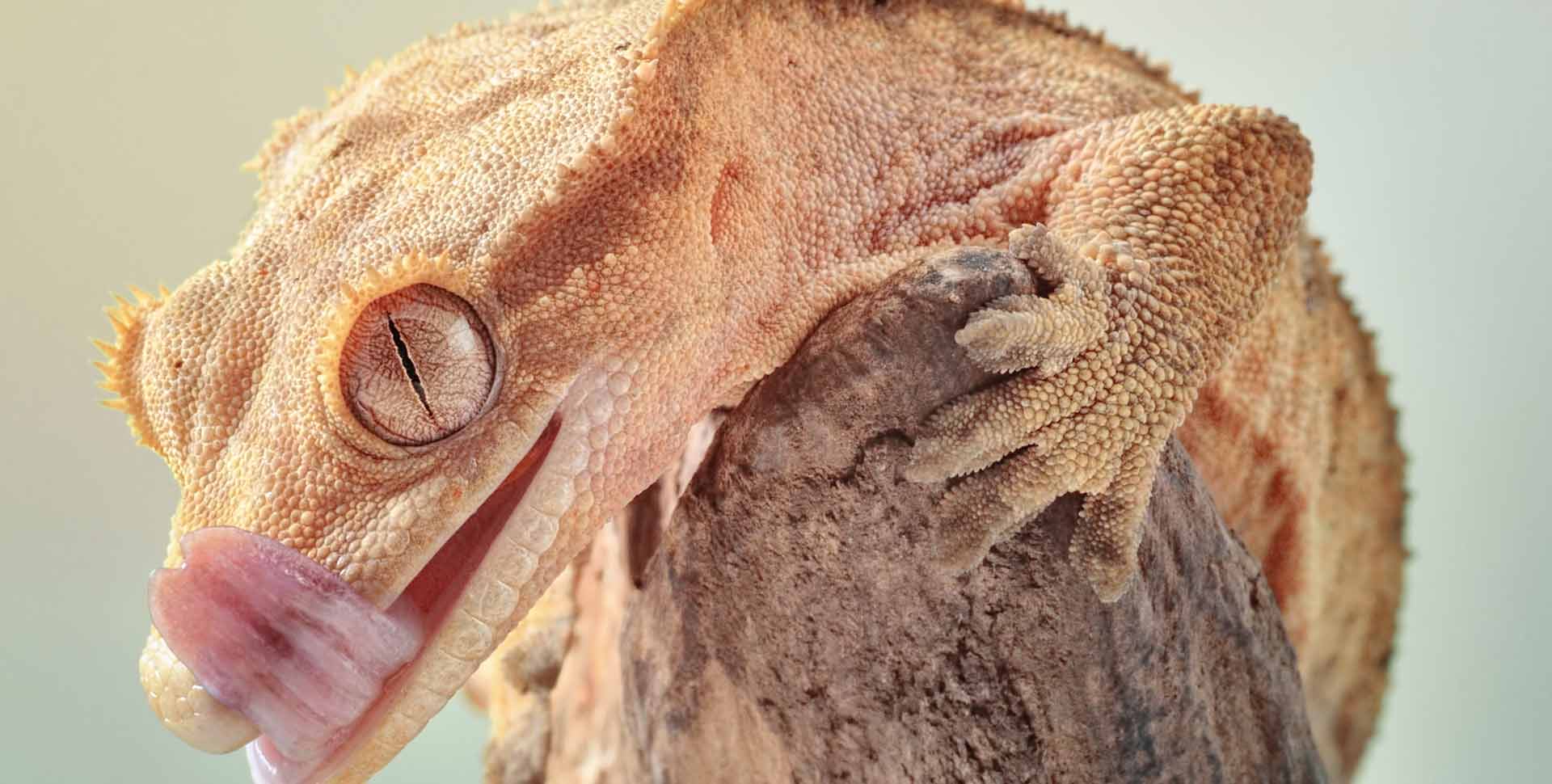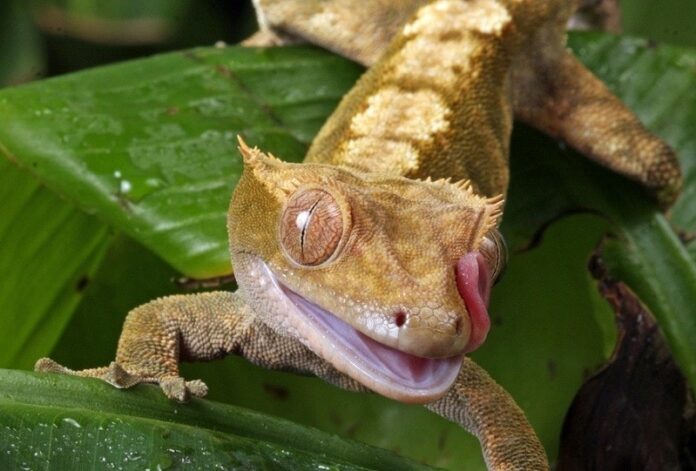Last Updated on August 21, 2021 by Fumipets
Crested geckos were believed to be extinct until 1994 when they were “rediscovered.” Their popularity as pets has risen steadily since then. They’re a low-maintenance pet that’s ideal for kids or first-time lizard owners with little time to commit to daily upkeep. Its eyelashes are one of their distinguishing characteristics, which is why they are also known as eyelash geckos. New Caledonia, an island nation off the coast of Australia, is home to these lizards.
Crested Gecko Temperament and Behavior
Crested geckos appear in a variety of colours and patterns (morphs). The fringed crest that starts above their eyes and extends down their necks and backs gives them their name, but the size of the crest varies.
Crested geckos have unique toe pads that enable them to glide easily over vertical surfaces, and their prehensile tails contribute to their agility. They are also good jumpers.
Crested geckos are generally calm and docile, but they may be nervous and need to be handled with caution. Handling is generally unpleasant for them, so avoid it if at all possible. They may attempt to leap away from you, injuring themselves in the process. If handled forcefully or in an effort to flee, crested geckos may drop their tails; unlike other geckos, they do not regrow their tails. They will only attack if they feel threatened. Bites are surprising, despite the fact that they do not pain and do not produce blood.

Housing the Crested Gecko
A minimum of a 20-gallon tall terrarium is required for an adult Crested Gecko, although a bigger tank is preferable. Because crested geckos are arboreal, energetic, and need a lot of vertical room to climb, a tall tank is recommended. In a tall 29-gallon terrarium, two to three crested geckos may be kept. Because males are territorial, only one male should be kept per tank. For ventilation, you might use a glass terrarium with a screened side, although some keepers prefer screened enclosures.
Provide a range of heights and orientations of branches, driftwood, cork bark, bamboo, and vines for crested geckos to climb. Add a variety of silk or strong live plants (pothos, philodendron, dracaena, ficus) since they will hide in the plants for cover. Eliminate any uneaten food and spot clean to remove excrement every day. Use reptile-safe disinfectants to clean the whole terrarium and its ornaments at least once a month. To avoid bacterial development, you’ll need to change the substrate weekly or monthly, depending on the substrate.
Heat
All reptiles, being cold-blooded animals, must control their body temperature. For crested geckos, a temperature range of 72 to 80 degrees Fahrenheit (22 to 26.5 degrees Celsius) should be given during the day, with a decrease to 65 to 75 degrees Fahrenheit at night (18 C to 24 C). Temperature gauges should be used to ensure the cage does not overheat. At higher temperatures, crested geckos get stressed. A low-wattage red nighttime lamp serves as an excellent heat source while also allowing you to see the lizard at its most active time of day, which is at night. A heat source should not be placed on the top of the tank since these climbing geckos may come too near and get burnt.

Light
Light Crested geckos are nocturnal, therefore UVB illumination isn’t required. However, other experts believe that a modest amount of UVB illumination (about 5%) is good for reptile health in general. Any additional illumination will increase the enclosure’s temperature, so keep an eye on it. Also, offer a gecko hideaway so that geckos may escape the light if they so choose.
Humidity
Crested geckos need a moderate to high degree of humidity. Aim for 60% humidity during the day and 80% at night.1 Use a hygrometer (humidity gauge) to track levels on a regular basis. Mist with warm, filtered water on a frequent basis to provide humidity. You may need to spray your cage a few times a day to maintain the humidity up, depending on your arrangement. At night, when the geckos are most active, make sure the cage is well-misted. Get an automated mister or fogger to provide humidity to the cage at scheduled intervals if you aren’t there during the day or can’t manually wet the enclosure.

Substrate
Most pet owners line the bottom of their cages with a substrate. Consider pet safety, simplicity of cleaning, and if the substrate helps to maintain humidity when choosing a substrate for a gecko. Coconut fibre bedding, moss, or peat are good surfaces for crested geckos. You may also use newspaper or paper towels, but they won’t look as nice.
If your crested geckos are prone to swallowing substrate while hunting, use sphagnum moss (either alone or over another substrate such as coconut fibre) or paper towels. Juveniles should be given paper towels since they are more prone to ingest other substrates by mistake.
Gravel or pebbles, although beautiful, are not a good substrate since they are difficult to clean properly and on a regular basis. Reptile sand and non-organic soil substrate should be avoided since they may be swallowed.
Nutrition
Because crested geckos are nocturnal, feed them in the evening. Feed juveniles three times a week and adults once a week.
The simplest method to guarantee a well-balanced, healthy food for crested geckos is to feed them a commercial crested gecko meal. Crickets and other prey insects may be used to supplement that diet (roaches, waxworms, silkworms). Mealworms have a stiff, indigestible exoskeleton, so don’t feed them. Feed as many prey insects at once as the gecko happily consumes for diversity and to enable the gecko to practise his hunting instincts.
Insects given to your gecko should be somewhat smaller than the distance between his eyes and gut-loaded or fed healthy meals before being fed to your reptile. Dust the insects three times a week with a calcium/vitamin D3 powdered supplement to increase your reptile’s vitamin and mineral intake. Once a week, dust prey with a multivitamin powder supplement.
Fruit is consumed by crested geckos on a weekly basis. Try mashed fruit or baby food from a jar. Bananas, peaches, nectarines, apricots, papaya, mangoes, pears, and passion fruit are all favourites.
If you can’t locate a commercial gecko diet, provide a mix of insect prey and fruit. This isn’t the most well-balanced diet, but it’ll do in a hurry or for a limited time. In this instance, crickets are the ideal bug to use, with the addition of additional insects for diversity.
Providing a small shallow water dish with fresh water on a regular basis is recommended, but they will most likely prefer to sip water droplets off leaves in the humid environment.

Common Health Problems
Geckos are susceptible to a few health issues that may be treated by an exotics veterinarian.
Excess mucus and redness around the mouth are signs of mouth rot or stomatitis. Respiratory infection symptoms include wheezing or drooling. Skin issues include a rash, which can be a sign of a parasitic infection; uneven or difficult shedding, which can be caused by insufficient enclosure humidity.
Purchasing a Crested Gecko
Despite the fact that crested geckos are readily accessible at pet shops, attempt to get one from a reliable breeder. A crested gecko may cost anywhere from $40 to $150, depending on the rarity of the hue or mutation.
Make sure your gecko can climb effectively, has a straight spine, and has no obvious ribs or pelvic bones when choosing one.
It should have a vibrant and alert appearance. It should also have bright eyes, a clean nose, and a vent (faecal opening).


















